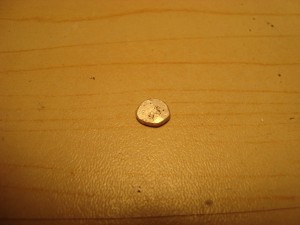I’m part way through a long project, and I’m going out of town next week so I won’t have any new projects to post for a while, so I though I might put up something small in the meantime.
One of the things that was brought up in the Ronda Coryell fusing workshop I attended was how easily you can fuse scrap into a ball. I, like other students, have had issues when reclaiming sterling and sometimes end up with a less than ideal ingot that has poor working properties.
For students this can be very frustrating, due to the small amounts of metal we usually keep on hand. Seldom does a student or hobbyist use metal on such a scale that sending in scrap is really useful. It’s very handy to be able to take clean scrap on the order of 1/4 ounce to 2 ounces and reclaim it in an effort to make some sheet or wire.
Interested in this, I took the bits left from the piercing out of the benzene ring in the last post, and tossed them on a compressed charcoal block with the adhesive and paper on them still. Using the Gentec small torch, with propane and oxygen set to a slightly reducing flame, I heated the bits pretty aggressively. The paper and binder burned away quickly, the ball formed up, and a little of it was accidentally blown off by the force of the torch. I heated the remaining liquid metal for several seconds to ensure it had ample time to divest itself of carbonaceous crap, and to abuse it just a little. The new ball was cooled to black heat, and quenched. The formed ball was quite nice looking, and to give it a simple (although inadequate) test I hit it with a ball peen hammer on an anvil a few times to see if it would crack.
It seems to have come out quite well. The dark spots are surface garbage and not porosity. To be fair this was a loaded example, and the paper and binders most likely added to the reduction atmosphere. None the less, a good first try. Soon I should have enough scrap to make more than a 3-5 mm ball. I’ll reclaim it and roll it out, and try to directly compare with some sterling.
jasondeck
Latest posts by jasondeck (see all)
- Rutilated Quartz Pendant in Argentium - February 10, 2010
- Argentium baby spoon, with Keum Boo - October 12, 2009
- Reclaiming Argentium - July 8, 2009


{ 4 comments… read them below or add one }
I haven’t experimented much without the charcoal when melting fusing argentium yet. During her workshop, and in her DVDs Ronda Coryell is very specific about using charcoal, so I have been sticking to it.
In the future when I have more time to play with it I’m going to have to try some different conditions, including standard soldering boards and bricks.
My experience has shown that a reduction atmosphere is not needed. In fact, I have found that I get much cleaner results using no charcoal or reducing flame. Because of the affects of the Germanium, Argentium Sterling Silver seems to prefer an oxygen rich environment. Whenever I work with AS, I only place flux in the area I intend to fuse or solder. If you simply melt the AS on a clean soldering board (not charcoal or flux), you should find the resulting balls to be very clean and bright.
Marty Andersen
Using Argentium® Sterling Silver – Casting, Fabrication, Fusing and More
http://andersen.userblogs.ganoksin.coms/
The post has to do with student skill level reclamation of argentium. Many of the students in the school don’t use enough silver to have to worry about reclamation, and those that do reclaim it fairly infrequently. Consequently the quality of the ingot suffers from lack of experience/practice. I’m hoping that the argentium adds sufficient leeway in melting to aid the inexperienced.
Was this post specifically to do with Argentium sterling? If so I apologise. I regularly collect solderless regular sterling scrap together and melt it into quite large balls, which are then pickled, hammered flatter until they’ll go through my rolling mill and then rolled to the desired thickness – all with regular annealing. This way I can produce sometimes quite large sheets, or smaller ones if I want them to remain quite thick, say 1-2 mm thick. They often do start to crack just at the edges after a few passes through the rolling mill, but the portion I want in the middle has always been unscathed and has acted exactly the same as sterling which I’ve purchased. I pretty much always make cufflinks this way. It’s a great tool in the toolbox.
Helen Hill